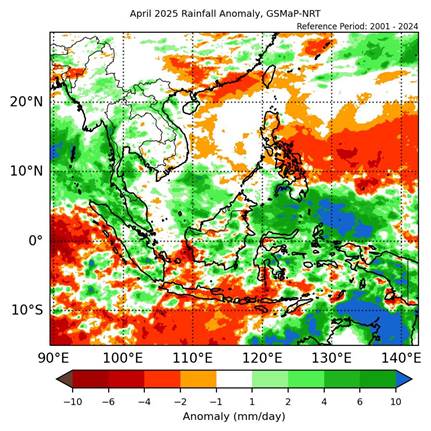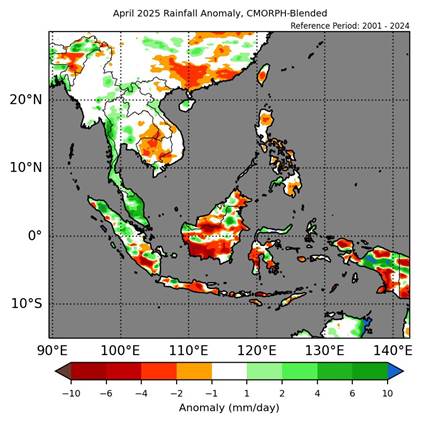Review of Regional Weather for April 2025
1. Overview
1.1 During April 2025, much of the western Maritime Continent and western Mainland Southeast Asia experienced above-average rainfall, while much of the southern and northeastern Maritime Continent experienced below-average rainfall (Figure 1). The largest positive (wetter) anomalies were recorded over the Malay Peninsula. Outside of the regions mentioned above, there was either disagreements between GSMaP-NRT and CMORPH-Blended datasets or no notable anomalies. For much of the central and eastern equatorial region CMORPH-Blended recorded below-average rainfall, while GSMaP-NRT recorded above-average rainfall. CMORH-Blended also recorded below-average rainfall for Cambodia, while GSMaP-NRT was near-average.
1.2 The observed rainfall anomaly pattern of above-average rainfall over much of western Mainland Southeast Asia and the western Maritime Continent and drier conditions over the northeastern Maritime continent is consistent with the predictions from the subseasonal weather outlooks for April 2025 (31 March – 13 April 2025, and 14 – 27 April 2025). The observed pattern is also partly consistent with the April 2025 seasonal outlook of above-normal rainfall over western Mainland Southeast Asia, although the northwestern Maritime Continent was predicted to have a higher chance of above-normal rainfall.
1.3 Below-average and near-average temperatures were recorded over most of Southeast Asia in April 2025, apart from over northern Myanmar and the Philippines (Figure 2). The coldest anomalies (-1°C – -2°C below average) were recorded over parts of western and southern Myanmar, associated with regions of above-average rainfall. The warmest anomalies (1°C – 2°C above average) were recorded over northern Myanmar.
2. Climate Drivers
2.1 There was no discernible Madden-Julian Oscillation (MJO) signal for most of April based on the RMM diagram (Figure 3). During the last week of April, there were signs of an MJO signal over the Western Pacific (Phases 6 and 7) and the Western Hemisphere (Phase 8). Phases 6 and 8 tend to bring drier conditions to parts of the Maritime Continent at this time of the year, although this is not noticeable in the April rainfall anomalies, particularly for GSMaP-NRT.
2.2 ENSO-neutral conditions were present in April 2025. Sea surface temperatures in the Nino3.4 region (used to monitor ENSO) indicated a return to ENSO-neutral. Key atmospheric indicators of La Niña (reduced cloudiness and stronger trade winds in the central Pacific) were present earlier in March, but have since shown signs of weakening, in line with a transition to ENSO-neutral conditions.





